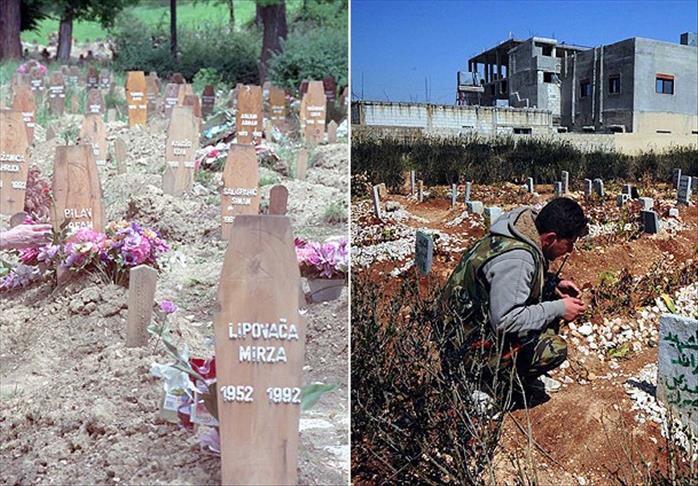
SARAJEVO
The violence continuing for 18 months in Syria has brought to minds the painful incidents in Bosnia-Herzegovina between 1992-1995.
The acts of violence in Syria have refreshed the pain of Bosnians who were victims of a war 20 years ago.
Feeling deeply sad over seeing a tragedy, one that resembled their own tragedy years ago, in a Muslim country, Bosnians remembered the painful days of the war due to the incidents taking place in Syria.
The statistics pertaining to violence in both countries resembled each other although the geographies may be different.
Around 30,000 people lost lives in Syria after violence erupted in early 2011. 5,000 of those killed were women and children. Around 55 people become victims of violence on a daily basis in Syria, a country with a population of 17.5 million people.
All those experienced in Bosnia-Herzegovina were not much different than those in Syria. Around 200,000 people were killed in the war of 1992-1995 in Bosnia-Herzegovina. This figure implies that 140 people were killed in Bosnia-Herzegovina on a daily basis. The number of women and children killed in Bosnia-Herzegovina is close to the number of women and children killed in Syria.
11,451 residents of Sarajevo were massacred during the 44-month siege of Sarajevo, Bosnia-Herzegovina's capital. Most of those who were killed were Bosnians, Serbians, Croatians, Jews and Gypsies.
The siege of Sarajevo is known as the longest siege of a European city since the end of the Second World War. During the siege, eight people were killed daily, including one child. In only a single month, 261 people, including 36 children, were getting killed in Sarajevo.
Two different wars, same destiny
During 18-month long clashes in Syria, one out of every 45 Syrian nationals left their homes. According to international observers, more than 400,000 Syrians legally or illegally left their country.
During the war in Bosnia-Herzegovina, one out of every two citizens left the country. Out of a total population of 4.3 million people, 2.2 million citizens of Bosnia-Herzegovina had to leave their country during the four year war. Around 400,000 citizens of Bosnia-Herzegovina still live out of their country.
The scenes on the streets of Sarajevo 20 years ago resemble those in the streets of Syria today.
There was no difference between the killing of 25 Syrians who were waiting in a queue for bread on August 16 and the killing of 26 residents of Sarajevo while they were in a queue for bread on Ferhadiye Avenue on May 27, 1992. In a similar fashion, 11 people in Sarajevo's Alipasino Polye district were killed in 1992 while in queue for bread or water.
During the war in Sarajevo, individuals lost lives in the Markale Market and Sarajevo's central market. Today, Syrians get massacred in markets in a similar manner.
No lessons learned from Srebrenitsa
Opening fire on a mosque in Dara'a, Syria during Friday's prayers resembles the destruction of the Ferhadiye Mosque in Banja Luka, Alaca Mosque in Foca, and Atik Mosque in Bijeljina.
There is no difference in the destruction of artifacts listed on UNESCO's list of world cultural heritage in Syria and the destruction of the Mostar Bridge by the Croatian Defense Council (HVO) on November 9, 1993.
The global public opinion only watches the killing of children in Syria on TV sets as they did during the painful days of the war in Bosnia-Herzegovina.
Today, the Syrians expect international organizations to see their pain and to end the massacres perpetrated by Assad.
In a visit made to Bosnia-Herzegovina's Srebrenitsa city in July, the UN Secretary General Ban Ki-moon said that all those experienced during the Bosnian war resembled Syria today.
Speaking to reporters after visiting the martyrdom of Srebrenitsa, Ban Ki-moon had said that "after learning lessons in Srebrenitsa, the international community must immediately work to end the massacres in Syria. I would not want my successors to go to Syria after 20 years and make apologies for the incidents experienced".
"The international community is going through a test in Syria. The United Nations is doing all it can but the international community must act together so tangible steps could be taken on Syria. If we can not act together, bloodshed in Syria would continue. Today, I call on the whole world from the heart of Bosnia-Herzegovina. Do not be late, unite and work to end the bloodshed in Syria," Ban Ki-moon had also said.
Terror of sharpshooters
As was the case for the civilians during the Bosnian war, one of the elements that terrorize civilians is Syria is the use of snipers.
Similar to what the Bosnian Serbian forces did, the forces of the Syrian regime target both the forces of the opposition and civilians.
Having been located in central spots of residential areas, the sharpshooters are a greater source for panic compared to other military units.
It is known that the Syrian administration uses sharpshooters not only in cities where clashes take place, such as Damascus, Aleppo, Idlib, Hama, Homs, and Deir ez-Zor, but also along their borders with Turkey and Lebanon.
Most of the more than 100 people getting killed in Syria daily do get killed by sharpshooters.
In a statement released in August, the Free Syrian Army's command post in Aleppo had said that around 2,000 weapons confiscated in a tobacco factory in Ayn Tel district were made either in Germany or the Czech Republic for the use of sharpshooters.
The fact that the scenes which took place in Bosnia between 1992-1995 are getting experienced in Syria shows that the international community has not learned lessons from Srebrenitsa.
While looking at the incidents in the streets of Syria, the mothers of Srebrenitsa remembered the massacre of 8,372 people, most of whom were men, in Srebrenitsa 17 years ago.
A translator for the Dutch battalion during the war and an individual who lost parents and a brother, Hasan Nuhanovic stressed that the international community did not learn any lessons from Srebrenitsa when one thinks of the incidents in Syria.
"The UN appointed Kofi Annan as a special envoy to end the violence in Syria. As in most other areas, this issue resembles Bosnia," Nuhanovic underlined.
"It was Kofi Annan who was given the duty to facilitate peace in Bosnia-Herzegovina while massacres took place in Srebrenitsa," Nuhanovic noted.
"Annan is the same person whom the UN appointed as envoy for Syria. Annan was receiving all information pertaining to Srebrenitsa under siege and Bosnia. At the time, Annan could not fulfill his duties. The UN covered up many incidents in Srebrenitsa. It is highly interesting to see that the UN sent the same person to put off the fire in Syria. The UN seems to have not learned lessons from the results that Annan led to and the massacre in Srebrenitsa. Annan gets sent to Syria after 17 years and could not do anything. This is just unacceptable," Nuhanovic indicated.
"The UN is not effective in preventing clashes in most parts of the world. During the Bosnian war, there were UN forces and a total of 20,000 troops. Furthermore, Srebrenitsa was a safe region under the command of the UN. They had the power to call NATO planes for help but they did not use it. UN troops are presently not serving in Syria. So, from this perspective, we can not compare Syria with Bosnia," Nuhanovic stated.
"I remember Srebrenitsa when I see the incidents in Syria"
The Chairperson of the Association of Srebrenitsa Jepa Mothers, Munira Subasic made a call on the international community to help end the tyranny in Syria before "a new Srebrenitsa takes place in Syria".
"There is simply no difference between what happened in Bosnia and what is taking place in Syria today. The tragedy experienced in Bosnia years ago gets repeated in Syria today," Subasic noted.
"Syrian children, like the Bosnian children 17 years ago, want to live in peace and not to remain hungry. Had the world wished for peace, this would not have happened in Syria. Seemingly, the international community is seeking for a new victim. Unfortunately, the victim always is an Islamic country. What Syria goes through now are things that we went through in Bosnia despite the protection of the UN. No one stopped the tyrants 17 years ago. At the present time, Bosnian mothers seek for the traces of their sons and husbands and look for their corpses. The tyrants continue to walk free," Subasic underlined.
A resident of Srebrenitsa, Zumra Sehomerovic said that she felt sorry and wounded due to the incidents in Syria.
"It seems as if the world leaders do not act unless a few thousand people get killed. I can understand the difficulties of the people in Syria. I went through similar things in Srebrenitsa. I remember everything as if they happened yesterday. I was so happy when I learned that world leaders would discuss the measures to be taken for Bosnia. However, those talks brought no results or benefits. After 17 years, I remember Srebrenitsa when I see the incidents in Syria," Sehomerovic said.
No results achieved after decisions
The UN Security Council takes decisions on Syria just as they did on Bosnia yesterday. Despite all the decisions, the UN could not bring peace to the Balkans. On the contrary, the troops of the Serbian Republic, supported by the Serbian army, massacred Bosnians under the supervision of the UN.
While many world leaders held daily meetings to stop the massacres in Bosnia, 140 people were killed in the Bosnian war on a daily basis. Likewise, one person gets killed in Syria every 25 minutes.
The UN brought up several proposals to invite the fighting sides to peace and an agreement in 1991 and 1992 but the proposals were not more than just words.
On January 8, 1992, the United Nations decided to implement an arms embargo on Bosnia. With such a decision, the UN officially prevented the Bosnians from defending themselves. The UN's decision helped the Serbian side who had weapons of the Yugoslavian army. On February 21, 1992, the UN adopted resolution no. 743 on the establishment of the UNPROFOR. However, this resolution did not help the victims.
The neighbors of Bosnia-Herzegovina on May 15, 1992 were called on to respect the territorial integrity of the country while the troops of the Yugoslavian army and the Croatian army were asked to leave the territory of Bosnia-Herzegovina. UN's decisions could not prevent the massacres of Serbian leaders and their ethnic cleansing.
UN resolutions
Economic sanctions were applied on Yugoslavia, led by Slobodan Milosevic, in May 1992 but no results were achieved through the sanctions.
While a resolution was adopted on August 13, 1992 underlining the ethnic cleansing in Bosnia-Herzegovina, such a resolution did not cause any reaction among the nations of the world.
The brutal terror in Bosnia-Herzegovina continued for three years. During the process, Bosnians were killed, got deported and were subject to mass tortures in camps.
The residents of Sarajevo were the target of sharpshooters and bomb attacks and had to live without food, water and electricity for months.
A resolution adopted by the UN on December 18, 1992 talks about mass sexual harassment that the women of Bosnia were subjected to. However, sexual harassment and rape incidents continued for three years as the world watched.
UN's famous resolution no. 819 gave Srebrenitsa the status of "safe zone". The "safe zones" were extended to the cities of Jepa, Tuzla, Sarajevo, Gorajde and Bihac but the daily killings of people left a black stain on the forehead of the UN.
Aside from the Washington Treaty that ended clashes with the Croatians and the Dayton Treaty that ended the war in Bosnia-Herzegovina, all efforts for peace in Bosnia-Herzegovina failed.
The Bosnians held the Serbians and the United Nations accountable for the inhumane treatment that they went through during the war.
Reporting by Faruk Vele / Senita Sehercehayic


